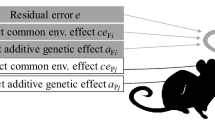Abstract
The effects of c and rd on jump-out and one-way avoidance learning were examined using both inbred strains and test crosses. Neither gene was found to retard either escape or avoidance performance in the jump-out task, although rd led to less accurate jumping. One-way performance, which required running through a small hole in a wall, was greatly disrupted in mice homozygous for rd; both escape latencies and learning rate were slower than those of mice with normal retinas. Two inbred strains with albinism did poorly on the one-way task, but no deleterious effects of c on one-way performance were detected in several test crosses. The absence of an albinism effect was not surprising, since all training was given under dim red light
Similar content being viewed by others
References
Anderson, K. V., and O'Steen, W. K. (1972). Black-white and pattern discrimination in rats without photoreceptors.Exptl. Neurol. 34, 446–454.
Bovet, D., Bovet-Nitti, F., and Oliverio, A. (1968). Memory and consolidation mechanisms in avoidance learning of inbred mice.Brain Res. 10: 168–182.
Bovet-Nitti, F. (1969). Facllitation of simultaneous visual discrimination by nicotine in four “inbred” strains of mice.Psychopharmacologia 14: 193–199.
Collins, R. L. (1964). Inheritance of avoidance conditioning in mice: A diallel study.Science 143: 1188–1190.
Creel, D. J., Dustman, R. E., and Beck, E. C. (1970). Differences in visually evoked responses in albino versus hooded rats.Exptl. Neurol. 29: 298–309.
DeFries, J. C., Hegmann, J. P., and Weir, M. W. (1966). Open-field behavior in mice: Evidence for a major gene effect mediated by the visual system.Science 154: 1577–1579.
Fuller, J. L., and Wimer, R. E. (1966). Neural, sensory, and motor functions. In Green, E. L. (ed.)Biology of the Laboratory Mouse, McGraw-Hill, New York.
Guillery, R. W., Amorn, C. S., and Eighmy, B. B. (1971). Mutants with abnormal visual pathways: An explanation of anomalous geniculate lamine.Science 174: 831–832.
Gyllensten, L., and Lindberg, J. (1964). Development of the visual cortex in mice with inherited retinal dystrophy.J. Comp. Neurol. 122: 79–90.
Henry, K. R., and Schlesinger, K. (1967). Effects of the albino and dilute loci on mouse behavior.J. Comp. Physiol. Psychol. 63: 320–322.
Kalil, R. E., Jhaveri, S. R., and Richards, W. (1971). Anomalous retinal pathways in the Siamese cat: An inadequate substrate for normal binocular vision.Science 174: 302–305.
Lashley, K. S. (1930). The mechanism of vision. III. The comparative visual acuity of pigmented and albino rats.J. Genet. Psychol. 37: 481–484.
McReynolds, W. E., Weir, M. W., and DeFries, J. C. (1967). Open-field behavior in mice: Effect of test illumination.Psychon. Sci. 9: 277–278.
Nagy, Z. M., and Misanin, J. R. (1970). Visual perception in the retinal degenerate C3H mouse.J. Comp. Physiol. Psychol. 72: 306–310.
Owen, K., Thiessen, D. D., and Lindzey, G. (1970). Acrophobic and photophobic responses associated with the albino locus in mice.Behav. Genet. 1: 249–255.
Pirenne, M. H. (1967).Vision and the Eye, Chapman and Hall, London.
Royce, J. R., and Covington, M. (1960). Genetic differences in the avoidance conditioning of mice.J. Comp. Physiol. Psychol. 53: 197–200.
Sorsby, A., Koller, P. C., Attfield, M., Davey, J. B., and Lucas, D. R. (1954). Retinal dystrophy in the mouse: Histological and genetic aspects.J. Exptl. Zool. 125: 171–198.
Stasik, J. H. (1970). Inheritance of T-maze learning in mice.J. Comp. Physiol. Psychol. 71: 251–257.
Tansley, K. (1954). An inherited retinal degeneration in the mouse.J. Hered. 45: 123–127.
Wahlsten, D. (1972a). Phenotypic and genetic relations between initial response to electric shock and rate of avoidance learning in mice.Behav. Genet. 2: 211–240.
Wahlsten, D. (1972b). Genetic experiments with animal learning: A critical review.Behav. Biol. 7: 143–182.
Wilcock, J. (1969). Gene action and behavior: An evaluation of major gene pleiotropism.Psychol. Bull. 72: 1–29.
Wimer, R., and Weller, S. (1965). Evaluation of a visual discrimination task for the analysis of the genetics of a mouse behavior.Percept. Motor. Skills 20: 203–208.
Winston, H. D., Lindzey, G., and Connor, J. (1967). Albinism and avoidance learning in mice.J. Comp. Physiol. Psychol. 63: 77–81.
Author information
Authors and Affiliations
Additional information
This research was supported in part by grant APA-398 from the National Research Council of Canada.
Rights and permissions
About this article
Cite this article
Wahlsten, D. Contributions of the genes albinism (c) and retinal degeneration (rd) to a strain-by-training procedure interaction in avoidance learning. Behav Genet 3, 303–316 (1973). https://doi.org/10.1007/BF01067607
Received:
Accepted:
Issue Date:
DOI: https://doi.org/10.1007/BF01067607




